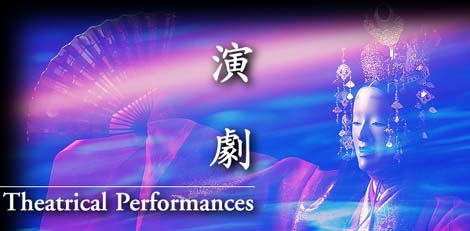

| The first historical record of Japan's history is the "KOJIKI", one of Japan's oldest books (compiled in 712 A.D. but relating to far earlier events). Its text tells of a dance performed by the goddess Ame-no-Uzume-no-Mikoto. In 612 A.D., a dramatic masked dance called GIGAKU was introduced into Japan from China. Next came BUGAKU and SANGAKU. BUGAKU was an aristocratic entertainment and SANGAKU, on the other hand, was civilian entertainment including music, dance, acrobatics, magic, and puppets. |
| Three hundred years later, Japan created its own version of dance, called SARUGAKU. This presumably livelier and more mischievous dance was very popular at shrine fairs and during local festivals, but not much is known about SARUGAKU. Even less is known about DENGAKU. DENGAKU was originally a fertility ritual performed in the fields. |  NOH |
 KYOGEN | In the late 14th century elements from both SARUGAKU and DENGAKU were drawn together into a similar but different kind of entertainment and this became NOH. A comical and realistic dialogue called KYOGEN developed as a compliment to NOH. |
| Since the 8th century, itinerant hunters and their women earned money by entertaining in cities. This entailed presenting episodic plays with small puppets that they operated with their hands. Known as NINGYO-JORURI, this puppet play was later called BUNRAKU. |
| KABUKI was first seen in the early 17th century. KABUKI's movement shows the influence of KYOGEN, BUNRAKU, and folk dance. Through a magnificent blend of playacting, dance, and music, kabuki today offers an extraordinary spectacle combining form, color, and sound and is recognized as one of the world's great theatrical traditions. |